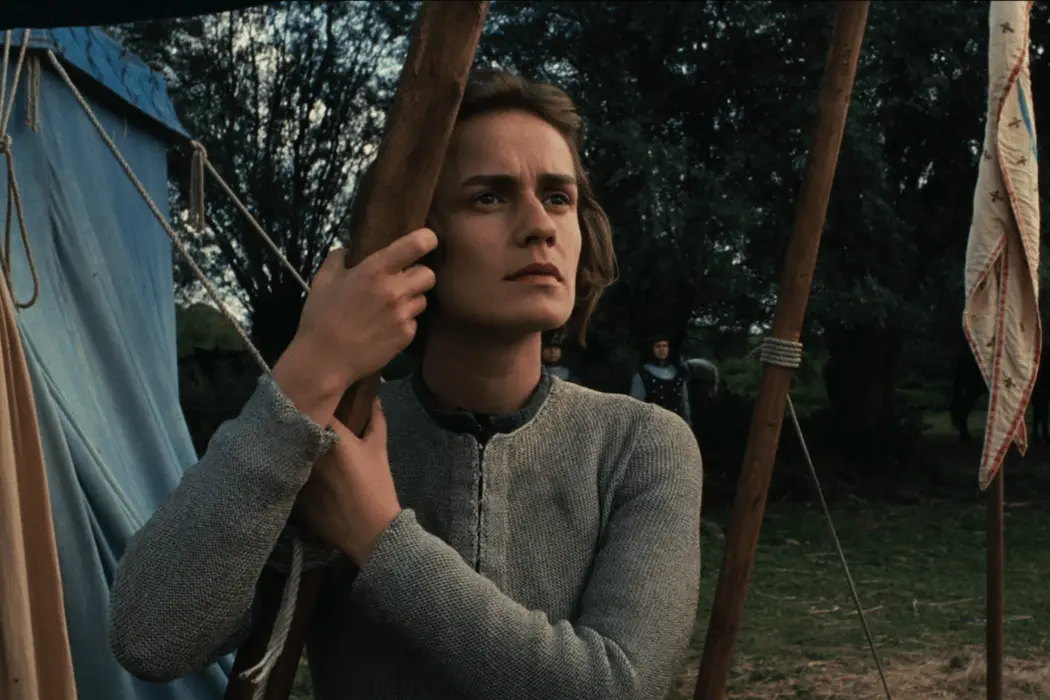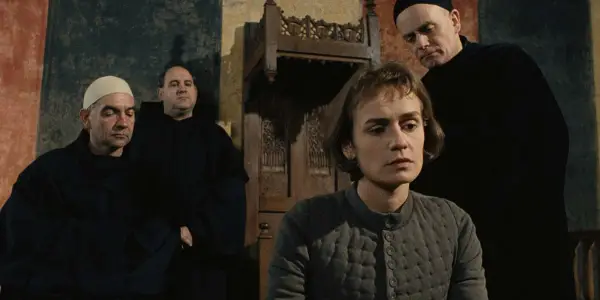JOAN THE MAID: Jacques Rivette’s Humble Interpretation Of A Famous Saint

A writer of fiction and criticism, and English student based…
The young woman known as Jeanne d’Arc, or Joan of Arc, is arguably the most famous once-living figure to achieve the gift of sainthood. A soldier in the French army by the age of sixteen, liberating towns in her home country at seventeen, and executed at nineteen, Joan was born into poverty, but at an early age was said to be greatly influenced by visions of Christian saints to become a warrior and overturn the results of the Hundreds’ Year War with the English. Against all odds and with the strengths of her faith, she achieved just that, marking her legacy as a symbol for religious virtue and martyrdom.
There have been a number of depictions in film that tell her story, from Carl T. Dreyer‘s The Passion of Joan of Arc, a silent-era essential, to Bruno Dumont‘s ongoing Jeanne trilogy which started as a heavy metal musical retelling of her childhood aspirations. Now for the first time on home media, the effort by the late French New Wave titan Jacques Rivette, entitled Joan the Maid, has its complete release: a six-hour epic in two parts revolving around exploring Joan of Arc’s achievements on the battlefield leading up to her burning at the stake. As one expects from Rivette, the approach he uses stands out from other takes on Joan, as it’s dedicated to the facts more than the myth, the strength more than the suffering, and the simple truth that a whole war and monarchy turned its attention on one person.
Part I: The Battles
From the very first scene, Joan the Maid proves to be a unique production, beginning with Joan’s Mother Superior speaking directly to the camera to deliver context to the place in time that has led to the young woman’s position in which we’ll begin to follow. These fourth-wall breaks occur often in the film as a form of documentary-like addresses, offering the recorded facts to the dramatized events we watch, and while a lesser director would make it feel like an overbearing gimmick, it falls into place the more Joan the Maid progresses. Sandrine Bonnaire performs the titular role, wearing a resilient expression at every moment, and the acts she performs throughout show that it isn’t simply a look of neutrality. As the first part’s title implies, Rivette covers the battles that Joan has fought and won, with a focus on how Joan worked her way into them through the intense determination and coercion towards the men in power.

It’s far from a new approach in the grand scheme of Rivette’s prior work, especially that in the 1970s. With films like Celine and Julie Go Boating, he was always fascinated by using female characters to defy and bend the world around them to achieve artistic or personal transcendence. His version of Joan of Arc is no different, often times coming off as aggressive toward the people she is attempting to convince.
What keeps Joan from coming off as some angry young woman is how the film justifies the frustration she feels towards these men. Some of her fellow soldiers are too immature to understand the weight of the battle, the commanding officers coddle her at every opportunity, and even the clergy wonder about her motives in the midst of these events. These opposing forces also watch as Joan becomes fully enveloped in her faith, with the film choosing not to show any of the visions she claimed to have, but only being observed in a kind of trance. With cinematographer William Lubtchansky utilizing subtle movements along various long takes, it’s a saving grace that the film doesn’t feel stagy. Every shot is layered with the symbols and banners of the period, reminding us all of the very system Joan operated within—and will eventually turn against her.
Part II: The Prisons
The inevitable fate of Joan of arc is the longest portion of this film, reaching a little under three hours. It doesn’t simply consist of Joan’s imprisonment and trial, but rather starting with the decisions made by those in power, including the newly crowned King Charles VII, whom she influenced, to sit on their hands and allow her to become a prisoner to face a pro-English party. A total dramatization of the trial and how Joan’s faith was seen as heresy has been seen all too often, and with Rivette’s background as a film critic, there was no doubt he understood that and opted to take an approach more steeped in a feminist reading, showing how an outspoken woman was persecuted for acting “out of turn.”

In reading the historical figure as an ordinary person, sympathy becomes easier to feel. It’s a brave take in how Joan the Maid doesn’t keep a grand focus on what Joan means to Christianity (even if religion does feature heavily in the film), and the buildup to her burning at the stake becomes more harrowing as a result.
This becomes the moment where Bonnaire’s performance shifts greatly, where the underlying apprehension breaks through her earlier demeanor, showing another common Rivette theme of performance. All the soldiers she shouted into shape begin to joke about her without her presence, and the leaders barely acknowledge her crisis in the wake of France’s recent victories. Performative actions are just as strong in politics as they are on the stage, so reflecting on the dynamics here gives a new weight to Joan’s life. It’s interpreted as this larger scale of power being shifted until the figures show their true colors, and with the corruption of monarchy and theocracy, which was at its height in this period, more progressive and determined minds such as Joan’s were bound to be persecuted. It’s a take that even in 1994 would have caused a conflict in discussion, but just enough of the piety to avoid a massive outrage, speaking truth to how Jacques Rivette’s intellect provided to film.
Joan the Maid: Conclusion
We’re living in a great time for cinema restoration. Joan the Maid has faced multiple releases, in which the meat of the film was cut. It was a detractor from what Jacques Rivette’s intent and four, and over 20 years passed before it was seen in all of its glory. Thanks to the Cohen Media Group, the 4K resolution has presented another masterpiece from the French filmmaker to new eyes, deserving of witnessing a revisionist perspective in a period where art is at its most introspective of past events. Rivette passed in 2016, but his views on film are on display with every creation he left behind, and Joan the Maid stands as his most ambitious and thought-provoking.
Joan the Maid, originally premiered on February 9, 1994, has been released on Blu-Ray in December 2019 by Cohen Media Group.
Does content like this matter to you?
Become a Member and support film journalism. Unlock access to all of Film Inquiry`s great articles. Join a community of like-minded readers who are passionate about cinema - get access to our private members Network, give back to independent filmmakers, and more.
A writer of fiction and criticism, and English student based in Baltimore. Berry’s aspirations of becoming an animator/filmmaker started young. It was a high school film studies course that shifted their interest to wanting to discuss them. They maintain a growing list of favorite films, ranging from Ingmar Bergman’s Persona to Stephen King’s Maximum Overdrive.













